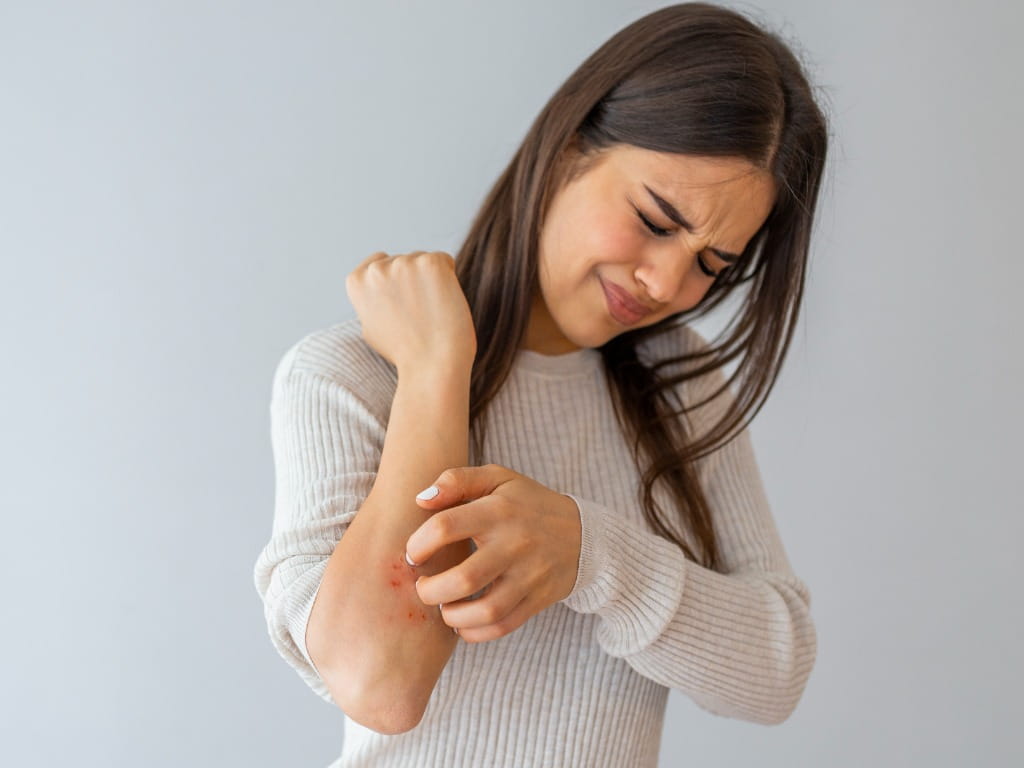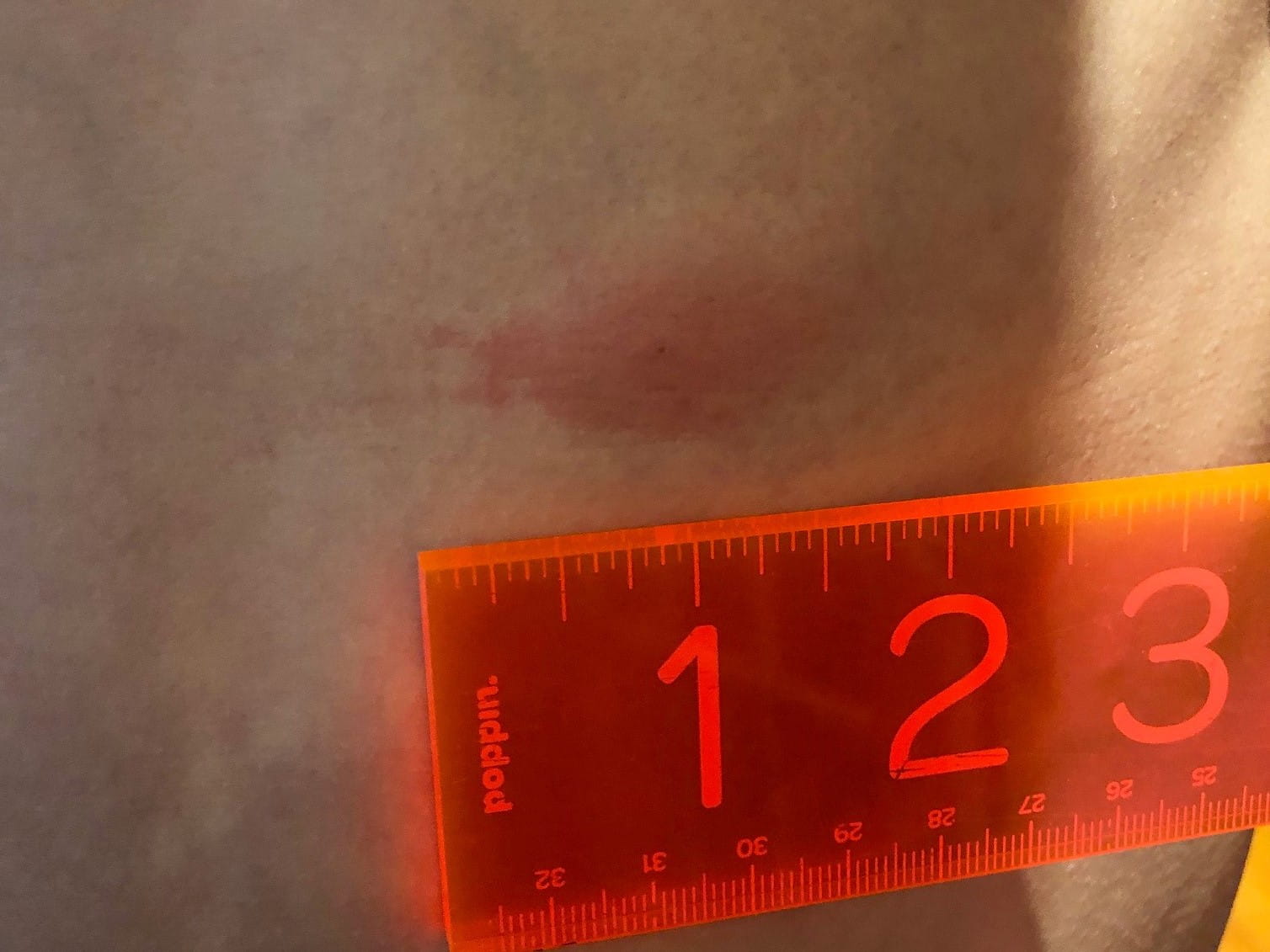Are Itch Mite Bites Dangerous?

The Bottom Line
Itch mite bites can cause intense itching and skin redness that can last for weeks. Because the mites are very small, most people do not remember being bitten. Over-the-counter products, including topical steroids and oral antihistamines, can be used to treat the itching caused by these bites.

What are itch mites?
Mites are arthropods and close cousins of spiders, scorpions, and ticks. There are thousands of mite species in the world. Some mites, such as scabies mites, can cause severe skin reactions in humans.
Itch mites are members of the Pyemotes family of mites. They feed on the larvae or nymphs of insects that are found in straw, grain, and wood (including furniture). Female mites inject toxic saliva into their prey. This paralyzes the prey and allows the mite to feed. Itch mite saliva is very poisonous to their prey, and a single mite can paralyze and kill an insect larva or nymph that weighs 166,000 times more than the mite itself. Don’t panic, the reactions when humans are bitten are not as serious!
How are people exposed to itch mites?
Although insect larvae represent the primary target of itch mites, the mites may bite humans when normal food sources are unavailable and humans enter infested areas. The bites are most likely to occur in late summer or early fall—when the itch mite populations are highest. One species of itch mite, the oak leaf itch mite (Pyemotes herfsi), feeds on insect larvae that live on oak tree leaves. As oak trees are common throughout the U.S., outbreaks of itch mite bites affecting humans have occurred in multiple states including Kansas, Nebraska, Texas, and Oklahoma. In 2021, oak tree itch mites were suspected as the cause of an outbreak of itchy skin rashes that occurred in people living in the Washington, D.C., area. The mites were likely feeding on cicada eggs and larvae that were in the oak tree leaves, and the mites fell from the trees onto unsuspecting people. It is thought that the large number of Brood X cicadas that hatched in 2021 provided a larger than normal food source for the mites, causing the mite population to blossom.
What happens when an itch mite bites a person?
Human contact with itch mites results in a painless bite followed by a skin reaction that is often extremely itchy. Itch mites are only 0.2 mm long and are not visible to the human eye. Because of this, people generally do not notice the bites when they occur. Itching, which is often severe, develops 10–20 hours after the bite and evolves into a large and reddened area of inflammation that can measure more than an inch in size. Repeated scratching of the itchy areas can lead to bacterial skin infections. The rashes associated with itch mite bites vary, and some are accompanied by skin streaking. Affected people might also develop fevers, chills, or headaches along with the skin reaction. In some cases, the itching and skin reaction can be confused with spider or bed bug bites, and it can be difficult to distinguish itch mite bites from those of chiggers, mosquitoes, or other insects. A history of intense skin itching and redness that occurs without a clear recollection of being bitten is suggestive of exposure to itch mites. Cool compresses, topical steroids (like 1% hydrocortisone cream), and oral antihistamines (such as Benadryl) can be used to treat the itching and skin rashes. Fortunately, the skin changes are self-limiting, and will often disappear within a few weeks.
How can I protect myself from itch mite bites?
It is very difficult to avoid being exposed to itch mites when they are present in the environment. The mites are tiny and can be carried by the wind over long distances. They can pass through window screens. To protect against itch bite mites, you should wear tightly woven clothing and shower with soap and water after spending time in areas where mites might be present. The insect repellent DEET can help protect against bites from some species of itch mites, although it is not 100% effective.
Kelly Johnson-Arbor, MD
Medical Toxicologist
Poisoned?
Call 1-800-222-1222 or
Prevention Tips
- Wear tightly-woven clothing and use DEET-containing insect repellent when outdoors, to avoid being bitten by mites and insects.
- If you think you have been bitten by itch mites, try to avoid scratching the affected areas to reduce the risk of infection.
- Cool compresses, topical steroids such as 1% hydrocortisone cream, and oral antihistamines can be used to treat the itching and redness associated with itch mite bites.
This Really Happened
A 30-year-old woman developed itching and reddened skin lesions on her chest and abdomen while staying in her vacation home in the South of Italy. She had not had any visitors for 10 months due to the COVID-19 pandemic. She did not recall being bitten by anything, had no contact with pets or other animals, and had slept with the bedroom windows closed. It was discovered that she had an old wooden nightstand next to her bed. Her skin reaction was believed to be caused by Pyemotes ventricosus, an itch mite that feeds on the larvae of Anobium punctatum (the common furniture beetle). Oral antihistamines and boric acid compresses on her skin were used to treat the skin changes. She was advised to get rid of the old nightstand and to hire an exterminator to fumigate the home. Once this was done, her itching and skin lesions completely resolved and did not recur (from Laghi et al., 2021).For More Information
If you have questions about adverse reactions from itch mite or other bites or stings, get guidance from Poison Control immediately. Help from Poison Control is available at www.poison.org and by phone at 1-800-222-1222. Both options are free, confidential, and available 24 hours a day.References
Poisoned?
Call 1-800-222-1222 or
Prevention Tips
- Wear tightly-woven clothing and use DEET-containing insect repellent when outdoors, to avoid being bitten by mites and insects.
- If you think you have been bitten by itch mites, try to avoid scratching the affected areas to reduce the risk of infection.
- Cool compresses, topical steroids such as 1% hydrocortisone cream, and oral antihistamines can be used to treat the itching and redness associated with itch mite bites.
